TOYOTA tC 2013 (in English) User Guide
Manufacturer: TOYOTA, Model Year: 2013, Model line: tC, Model: TOYOTA tC 2013Pages: 24, PDF Size: 4 MB
Page 11 of 24

OVERVIEW
FEATURES/OPERATIONS
SAFETY AND EMERGENCY FEATURES
9
FEATURES/OPERATIONS
Automatic Transmission (if equipped)
Park*
Reverse
Neutral
Drive
N
“S” mode
* The ignition switch must be “ON” and the brake pedal depressed to shift from
Park.
Downshifting increases power going uphill, or provides engine braking downhill.
For best fuel economy during normal driving conditions, always drive with the shift
lever in the “D” position.
Tilt steering wheel
Hold wheel, push lever down, set angle and length, and return lever.
NOTE: Do not attempt to adjust while the vehicle is in motion.
Lock release lever
Angle
Length
Parking brake
Pull(2) Push
(1) Pull slightly
(3) Lower
SetReleaseWindshield washer fluid tank
Engine coolant reservoir
Engine oil filler cap
Engine oil level dipstick
to the “Warranty Maintenance Guide.”
126471_2013Scion-tC.indd 95/8/12 9:58 PM
Page 12 of 24

10
FEATURES/OPERATIONS
Seat adjustments-Front
Seat position (forward/backward)
Height crank (driver side only)
Seatback angle
Seatback lock release
Seat adjustments-Rear
Seatback/Angle adjusting lever*
* Pull the lever up to adjust seatback angle, or fold down
Seats-Head restraints
Height
Lock release buttonLock release button
FrontRear
Height
126471_2013Scion-tC.indd 105/8/12 9:58 PM
Page 13 of 24
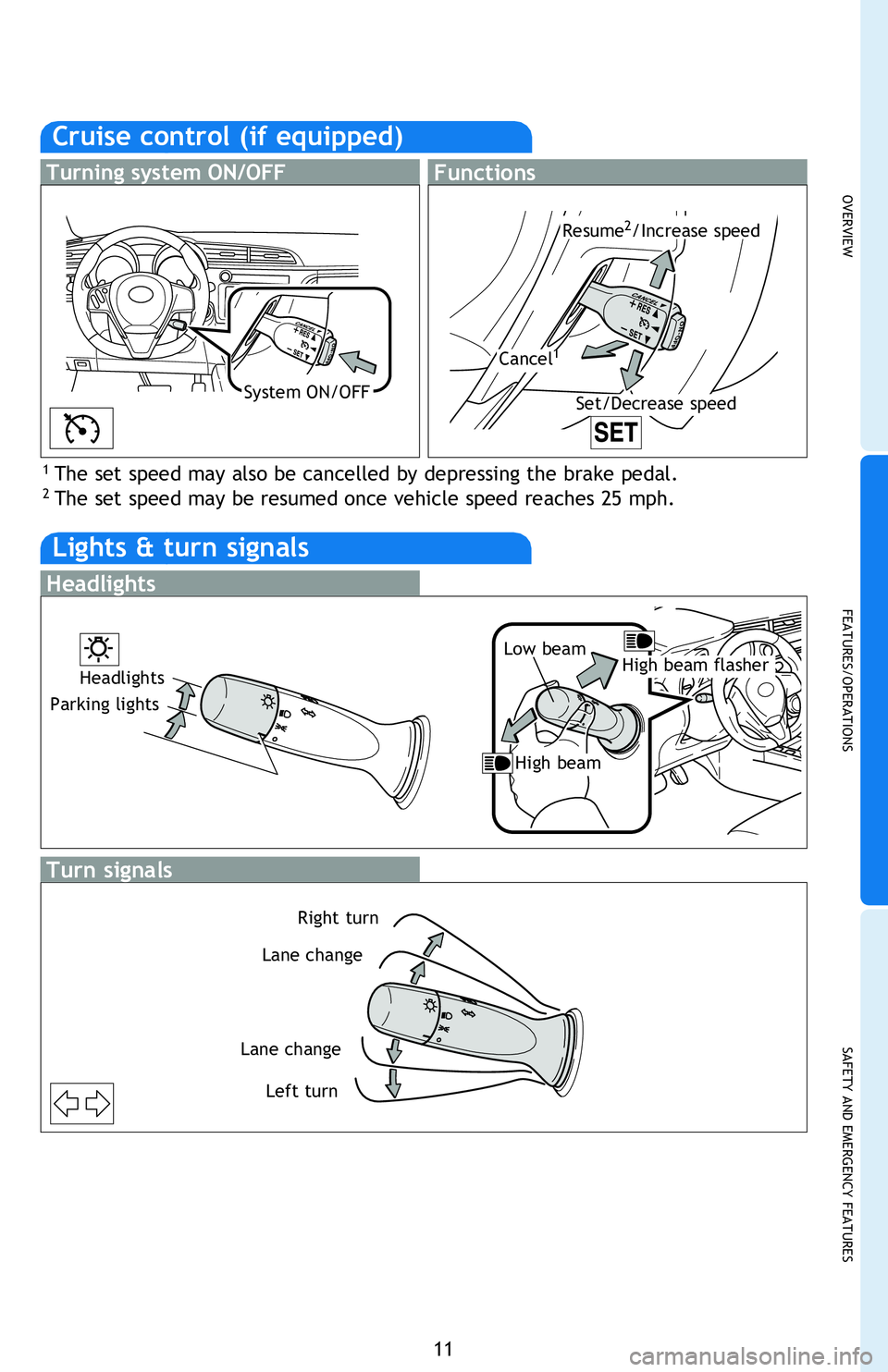
OVERVIEW
FEATURES/OPERATIONS
SAFETY AND EMERGENCY FEATURES
11
Cruise control (if equipped)
1 The set speed may also be cancelled by depressing the brake pedal.2 The set speed may be resumed once vehicle speed reaches 25 mph.
Turning system ON/OFFFunctions
System ON/OFF
Resume2/Increase speed
Set/Decrease speed
Cancel1
Lights & turn signals
Headlights
Turn signals
Parking lights
High beam flasher
Low beam
Headlights
Right turn
Left turn
Lane change
Lane change
High beam
Seat position (forward/backward)
Height crank (driver side only)
Seatback angle
Seatback lock release
* Pull the lever up to
adjust seatback angle,
or fold down
126471_2013Scion-tC.indd 115/8/12 10:17 PM
Page 14 of 24
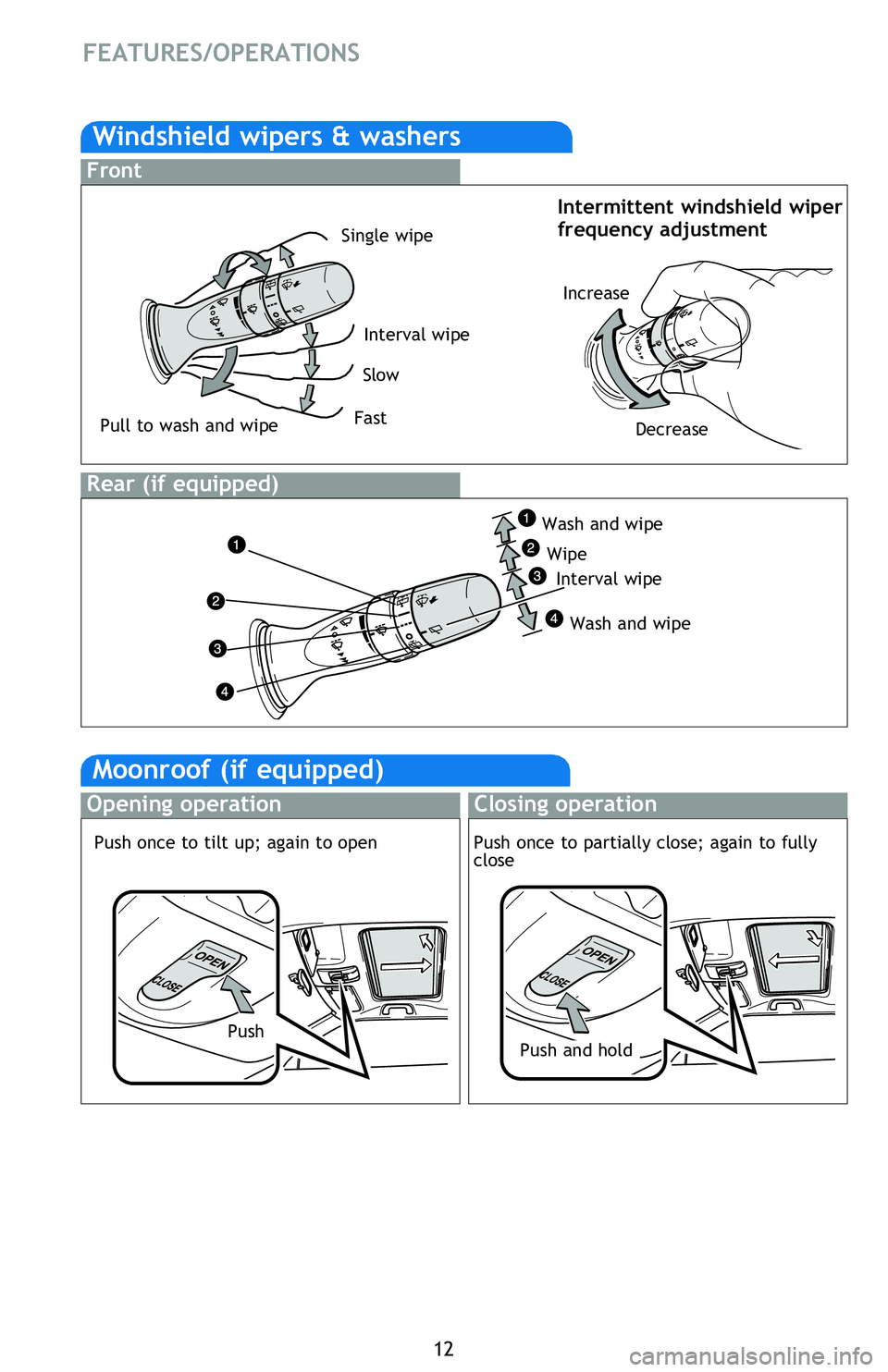
12
FEATURES/OPERATIONS
Intermittent windshield wiper
frequency adjustment
Windows
Automatic operation (driver’s window) Push the switch completely down and
release to fully open. To stop window midway, lightly push the switch in the
opposite direction.
Window lock switch Deactivates all passenger windows. Driver’s window
remains operable.
Windshield wipers & washers
Front
Rear (if equipped)
Interval wipe
Slow
Fast
Pull to wash and wipe
Single wipe
Interval wipe
Wipe
Wash and wipe
Wash and wipe
Moonroof (if equipped)
Opening operationClosing operation
Push and hold
Push once to tilt up; again to openPush
Driver door window controls
Clock
Light control-Instrument panel
Increase
Decrease
Push once to partially close; again to fully
close
126471_2013Scion-tC.indd 125/8/12 9:58 PM
Page 15 of 24
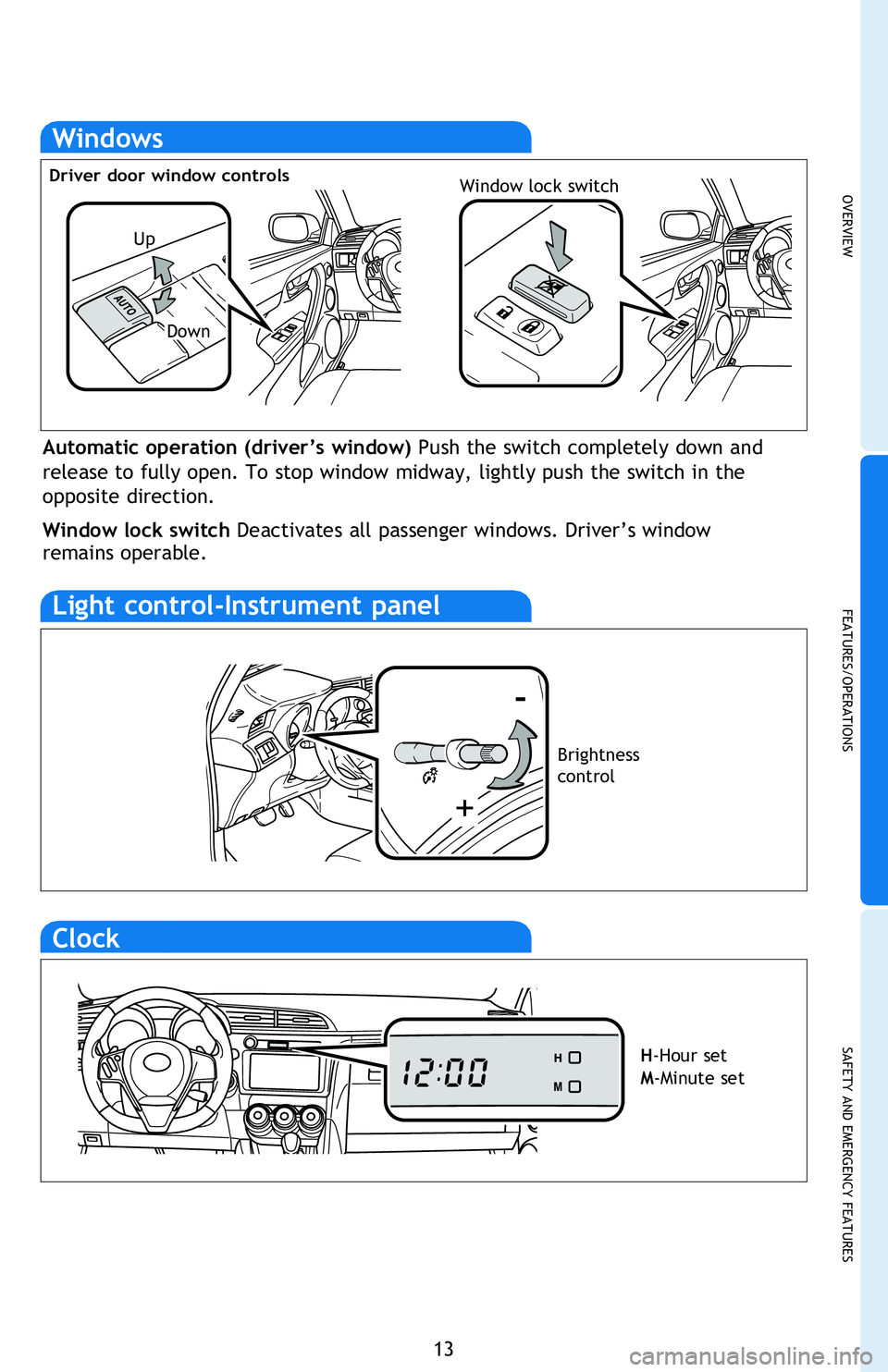
OVERVIEW
FEATURES/OPERATIONS
SAFETY AND EMERGENCY FEATURES
13
Intermittent windshield wiper
frequency adjustment
Windows
Automatic operation (driver’s window) Push the switch completely down and
release to fully open. To stop window midway, lightly push the switch in the
opposite direction.
Window lock switch Deactivates all passenger windows. Driver’s window
remains operable.
Closing operation
Window lock switchDriver door window controls
Up
Down
Clock
H-Hour set
M-Minute set
Light control-Instrument panel
+
-
Brightness
control
Push once to partially close; again to fully
close
126471_2013Scion-tC.indd 135/8/12 9:58 PM
Page 16 of 24
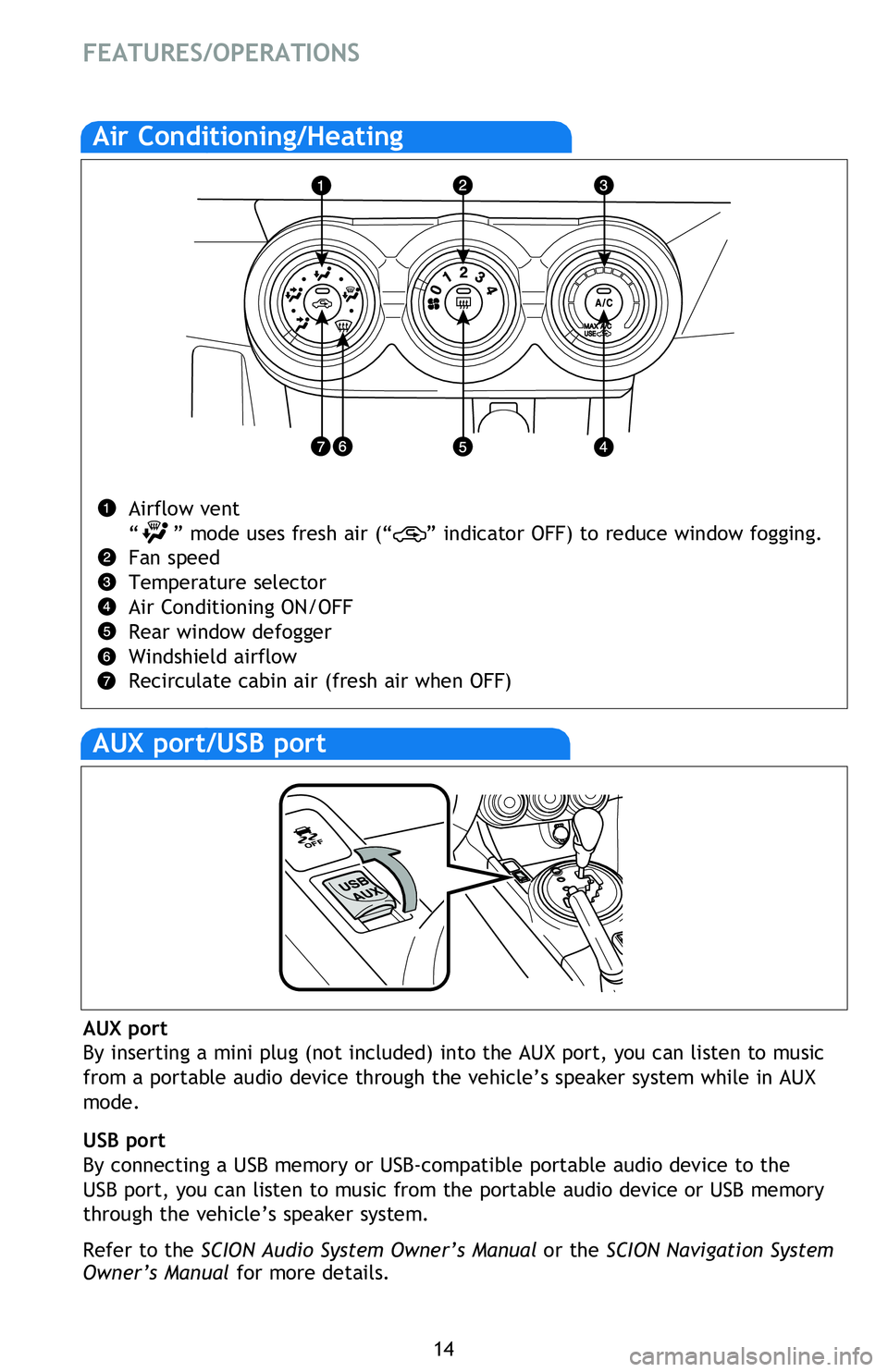
14
Air Conditioning/Heating
Airflow vent
“ ” mode uses fresh air (“ ” indicator OFF) to reduce window fogging.
Fan speed
Temperature selector
Air Conditioning ON/OFF
Rear window defogger
Windshield airflow
Recirculate cabin air (fresh air when OFF)
AUX port/USB port
FEATURES/OPERATIONS
®, etc.).
or the SCION Navigation System
AUX port
By inserting a mini plug (not included) into the AUX port, you can listen to music
from a portable audio device through the vehicle’s speaker system while in AUX
mode.
USB port
By connecting a USB memory or USB-compatible portable audio device to the
USB port, you can listen to music from the portable audio device or USB memory
through the vehicle’s speaker system.
Refer to the SCION Audio System Owner’s Manual or the SCION Navigation System Owner’s Manual for more details.
Ignition switch switch must be in the “ACC” or “ON”
126471_2013Scion-tC.indd 145/8/12 9:58 PM
Page 17 of 24
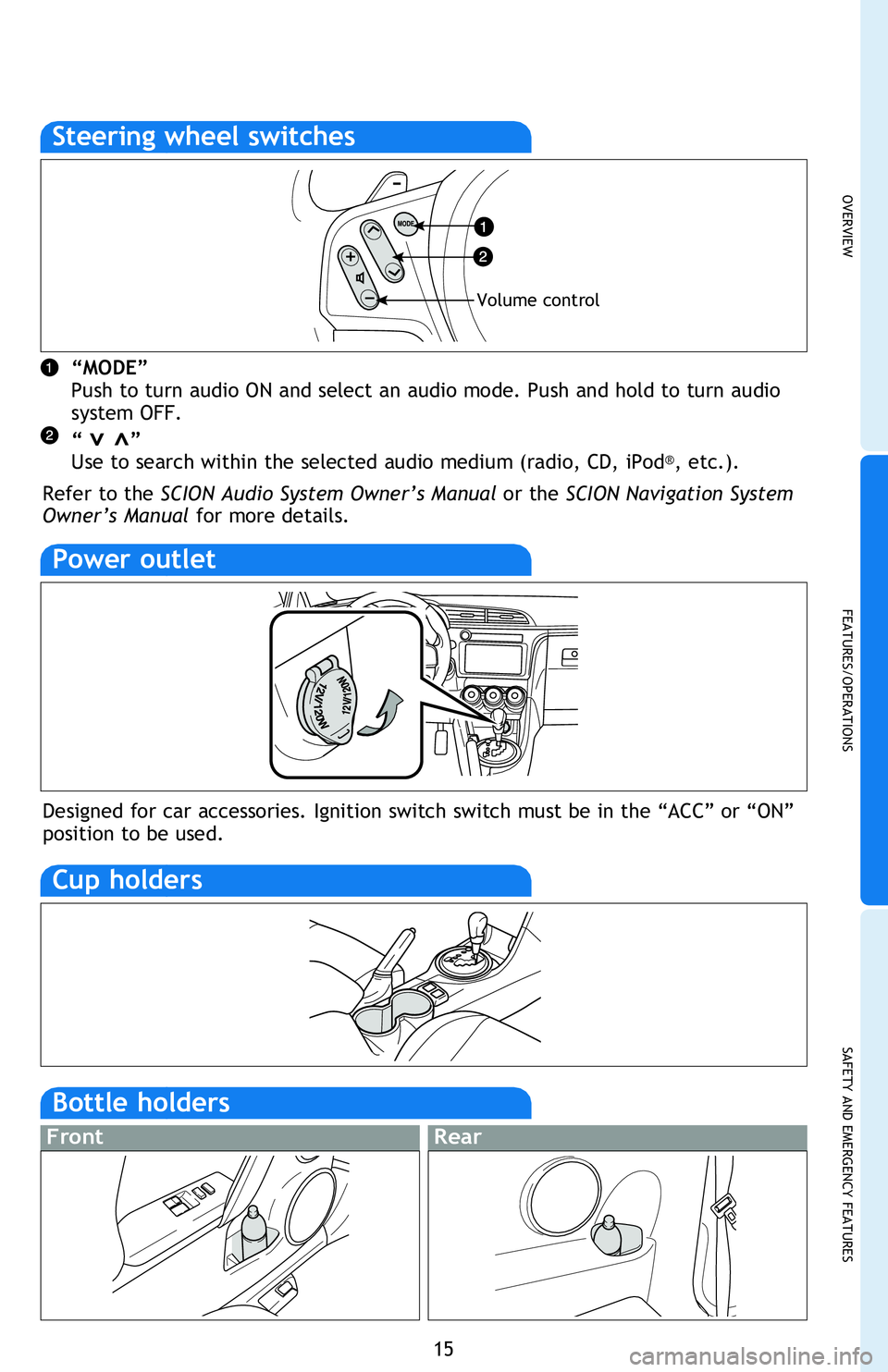
OVERVIEW
FEATURES/OPERATIONS
SAFETY AND EMERGENCY FEATURES
15
Airflow vent
Fan speed
Temperature selector
Air Conditioning ON/OFF
Rear window defogger
Windshield airflow
Recirculate cabin air (fresh air when OFF)
Steering wheel switches
“MODE” Push to turn audio ON and select an audio mode. Push and hold to turn audio system OFF.
“ ” Use to search within the selected audio medium (radio, CD, iPod®, etc.).
Refer to the SCION Audio System Owner’s Manual or the SCION Navigation System Owner’s Manual for more details.
>>
Volume control
AUX port
mode.
USB port
through the vehicle’s speaker system.
Refer to the SCION Audio System Owner’s Manual Owner’s Manual for more details.
Bottle holders
FrontRear
Cup holders
Power outlet
Designed for car accessories. Ignition switch switch must be in the “ACC” or “ON” position to be used.
126471_2013Scion-tC.indd 155/8/12 9:58 PM
Page 18 of 24
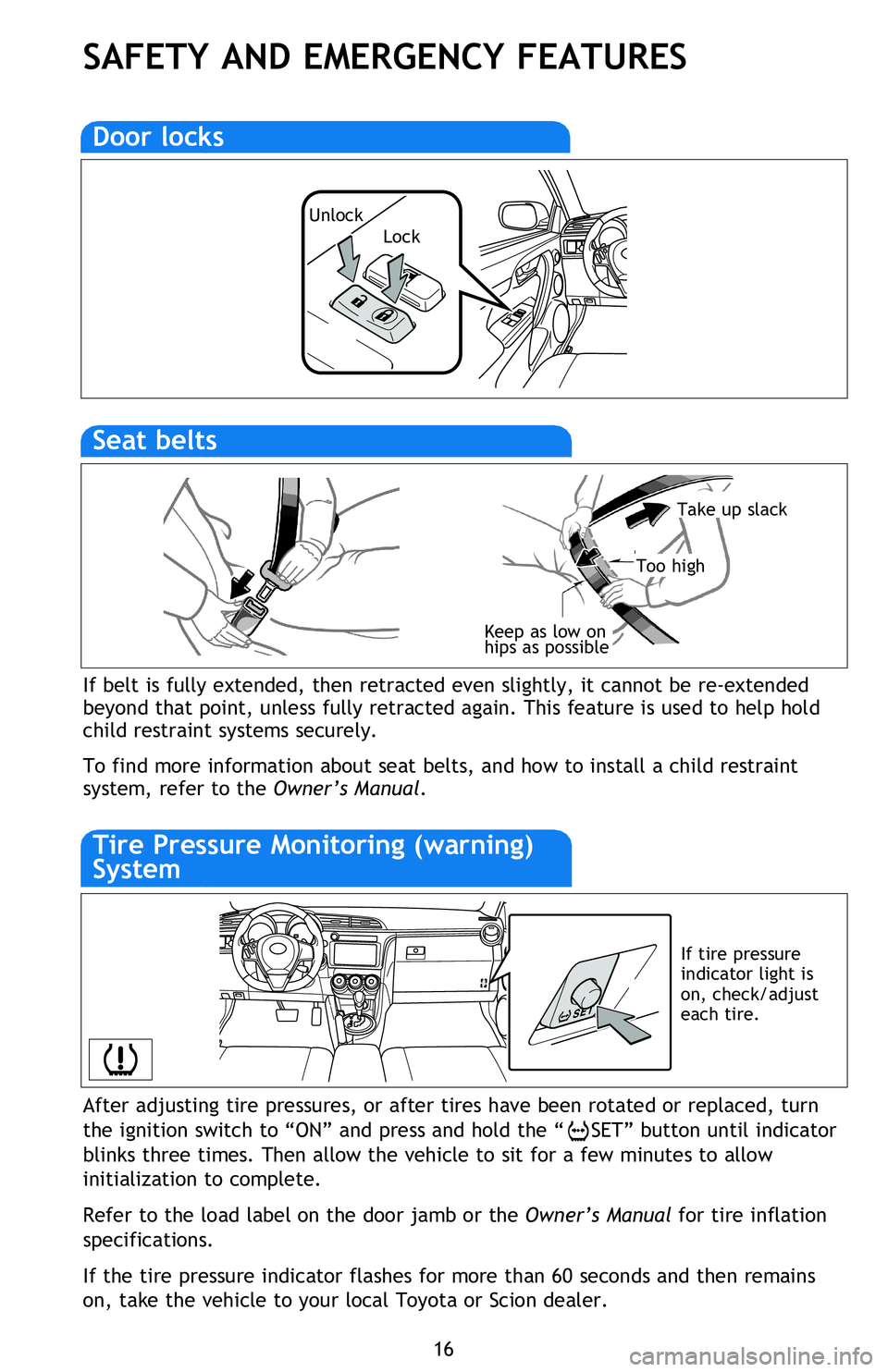
16
SAFETY AND EMERGENCY FEATURES
After adjusting tire pressures, or after tires have been rotated or replaced, turn
the ignition switch to “ON” and press and hold the “
SET” button until indicator
blinks three times. Then allow the vehicle to sit for a few minutes to allow
initialization to complete.
Refer to the load label on the door jamb or the Owner’s Manual for tire inflation
specifications.
If the tire pressure indicator flashes for more than 60 seconds and then remains
on, take the vehicle to your local Toyota or Scion dealer.
If belt is fully extended, then retracted even slightly, it cannot be re-extended
beyond that point, unless fully retracted again. This feature is used to help hold
child restraint systems securely.
To find more information about seat belts, and how to install a child restraint
system, refer to the Owner’s Manual.
Keep as low on
hips as possible
Take up slack
Too high
Seat belts
Lock
Unlock
Door locks
Tire Pressure Monitoring (warning)
System
If tire pressure
indicator light is
on, check/adjust
each tire.
Spare tire & tools
Tool location
Removing the spare tire
(1) Remove the spare tire cover.
(2) Loosen and remove the bolt.
Refer to the
Owner’s Manual for jack positioning and tire changing procedures.
126471_2013Scion-tC.indd 165/8/12 10:10 PM
Page 19 of 24

OVERVIEW
FEATURES/OPERATIONS
SAFETY AND EMERGENCY FEATURES
17
the ignition switch to “ON” and press and hold the “
initialization to complete.
Refer to the load label on the door jamb or the
specifications.
on, take the vehicle to your local Toyota or Scion dealer.
child restraint systems securely.
system, refer to the Owner’s Manual.
Spare tire & tools
Tool location
Removing the spare tire
(1) Remove the spare tire cover.
(2) Loosen and remove the bolt.
Refer to the Owner’s Manual for jack positioning and tire changing procedures.
Wheel nut wrenchFront towing eyelet
Jack handle
Spare tire
Jack
(1)
(2)
126471_2013Scion-tC.indd 175/8/12 9:58 PM
Page 20 of 24
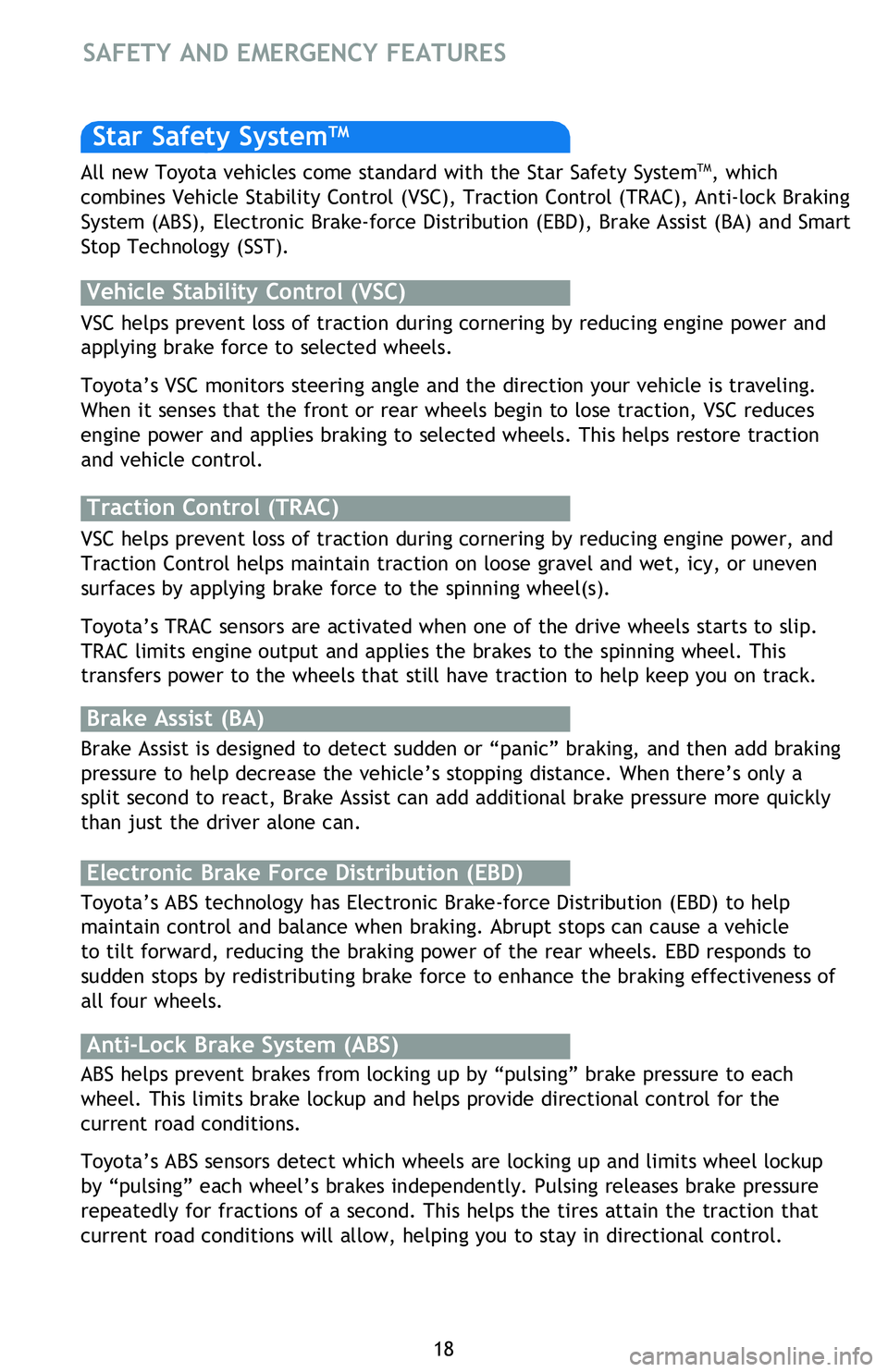
18
Star Safety SystemTM
VSC helps prevent loss of traction during cornering by reducing engine power and
applying brake force to selected wheels.
Toyota’s VSC monitors steering angle and the direction your vehicle is traveling.
When it senses that the front or rear wheels begin to lose traction, VSC reduces
engine power and applies braking to selected wheels. This helps restore traction
and vehicle control.
Vehicle Stability Control (VSC)
Anti-Lock Brake System (ABS)
Brake Assist (BA)
ABS helps prevent brakes from locking up by “pulsing” brake pressure to each
wheel. This limits brake lockup and helps provide directional control for the
current road conditions.
Toyota’s ABS sensors detect which wheels are locking up and limits wheel lockup
by “pulsing” each wheel’s brakes independently. Pulsing releases brake pressure
repeatedly for fractions of a second. This helps the tires attain the traction that
current road conditions will allow, helping you to stay in directional control.
Brake Assist is designed to detect sudden or “panic” braking, and then add braking
pressure to help decrease the vehicle’s stopping distance. When there’s only a
split second to react, Brake Assist can add additional brake pressure more quickly
than just the driver alone can.
VSC helps prevent loss of traction during cornering by reducing engine power, and
Traction Control helps maintain traction on loose gravel and wet, icy, or uneven
surfaces by applying brake force to the spinning wheel(s).
Toyota’s TRAC sensors are activated when one of the drive wheels starts to slip.
TRAC limits engine output and applies the brakes to the spinning wheel. This
transfers power to the wheels that still have traction to help keep you on track.
Traction Control (TRAC)
Electronic Brake Force Distribution (EBD)
Toyota’s ABS technology has Electronic Brake-force Distribution (EBD) to help
maintain control and balance when braking. Abrupt stops can cause a vehicle
to tilt forward, reducing the braking power of the rear wheels. EBD responds to
sudden stops by redistributing brake force to enhance the braking effectiveness of
all four wheels.
designed for your specific model.
mat at a time, using the retaining hooks to keep the mat in
side up.
SAFETY AND EMERGENCY FEATURES
All new Toyota vehicles come standard with the Star Safety SystemTM, which
combines Vehicle Stability Control (VSC), Traction Control (TRAC), Anti-lock Braking
System (ABS), Electronic Brake-force Distribution (EBD), Brake Assist (BA) and Smart
Stop Technology (SST).
126471_2013Scion-tC.indd 185/8/12 9:58 PM